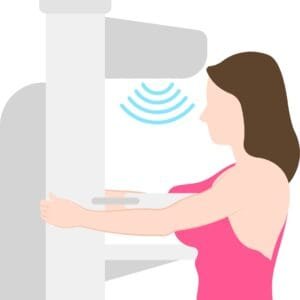Mammograms: A Crucial Tool for Breast Cancer Screening
What is a Mammogram?
A mammogram is a specialized X-ray imaging technique designed to examine breast tissue for abnormalities. It is widely recognized as a crucial tool for the early detection of breast cancer, often identifying changes in breast tissue years before symptoms appear.
Mammograms can detect small lumps, calcifications, or structural changes that may indicate the presence of breast cancer or other breast-related conditions.

Types of Mammograms
Screening Mammograms:
- Performed on women without symptoms as a preventive measure.
- Typically recommended every 1–2 years for women aged 40 and above.
Diagnostic Mammograms:
- Conducted when a woman exhibits symptoms such as lumps, pain, or nipple discharge.
- Offers a more detailed view of specific areas of concern.

How Does a Mammogram Work?
Mammograms use low-dose X-rays to capture images of breast tissue. The process is designed to highlight differences in tissue density, which can indicate abnormalities.
The Mammogram Procedure
Preparation:
- Avoid wearing deodorants, perfumes, or powders, as these can appear as artifacts on the images.
- Patients are advised to wear a two-piece outfit for convenience.
During the Procedure:
- The patient stands in front of a mammography machine.
- One breast is placed on a flat plate and compressed with another plate to spread the tissue evenly.
- X-ray images are taken from different angles.
Duration:
- The procedure typically takes 15–30 minutes.
Post-Procedure:
- Results are analyzed by a radiologist and shared with the referring doctor.

Purpose of Mammograms
Mammograms are primarily used for:
Early Detection of Breast Cancer:
- Identifies small tumors before they can be felt.
- Increases survival rates with early intervention.
Monitoring Breast Health:
- Tracks changes in breast tissue over time.
Evaluating Symptoms:
- Assesses lumps, nipple discharge, or breast pain.
Who Should Get a Mammogram?
- Women Aged 40 and Above:
- Annual or biennial screening is recommended.
- High-Risk Individuals:
- Women with a family history of breast cancer or genetic predispositions (e.g., BRCA mutations).
- Women with Symptoms:
- Those experiencing lumps, pain, or unusual changes in the breast.
Benefits of Mammograms
- Early Detection:
- Detects cancer at a treatable stage.
- Non-Invasive:
- Relatively quick and simple.
- Reduces Mortality:
- Proven to lower breast cancer mortality rates by 20–40%.
Limitations of Mammograms
- False Positives:
- May detect benign abnormalities, leading to unnecessary anxiety or procedures.
- False Negatives:
- May miss some cancers, particularly in dense breast tissue.
- Radiation Exposure:
- Although minimal, repeated exposure can be a concern over time.
Conditions Detected by Mammograms
- Breast Cancer:
- Tumors, microcalcifications, and other malignancies.
- Benign Conditions:
- Fibrocystic changes or non-cancerous growths like fibroadenomas.
- Inflammatory Conditions:
- Signs of mastitis or other infections.
FAQs About Mammograms
1. Who Can Perform a Mammogram?
Mammograms are conducted by trained radiologic technologists under the supervision of a radiologist.
2. What Qualifications Are Needed to Operate a Mammography Machine?
- A degree in Radiologic Technology or a related field.
- Certification from regulatory bodies such as the American Registry of Radiologic Technologists (ARRT) or equivalent in other countries.
3. Are Mammograms Painful?
- Some women may experience discomfort due to compression of the breast tissue.
- The discomfort is temporary and helps obtain clear images.
4. How Often Should a Woman Get a Mammogram?
- Women aged 40–49: Every 1–2 years based on risk factors.
- Women aged 50–74: Biennial screening is generally recommended.
5. How Much Does a Mammogram Cost?
In India, the cost typically ranges from ₹1,000 to ₹2,500, depending on the facility.
6. How Can One Set Up a Mammography Center?
To open a mammography center:
- Licensing and Accreditation:
- Obtain approvals from the Atomic Energy Regulatory Board (AERB) for operating X-ray equipment.
- Equipment:
- Purchase a mammography machine, which costs between ₹10 lakh and ₹50 lakh.
- Infrastructure:
- A dedicated room with lead shielding to minimize radiation exposure.
- Qualified Staff:
- Employ certified radiologic technologists and radiologists.
- Compliance:
- Adhere to national guidelines for radiation safety and quality control.
Conclusion
Mammograms are a cornerstone in the fight against breast cancer, offering early detection and improved survival rates. With advancements in imaging technology, mammograms continue to be a reliable and accessible method for ensuring breast health. By understanding their significance, preparation, and applications, individuals can take proactive steps toward better healthcare outcomes.
